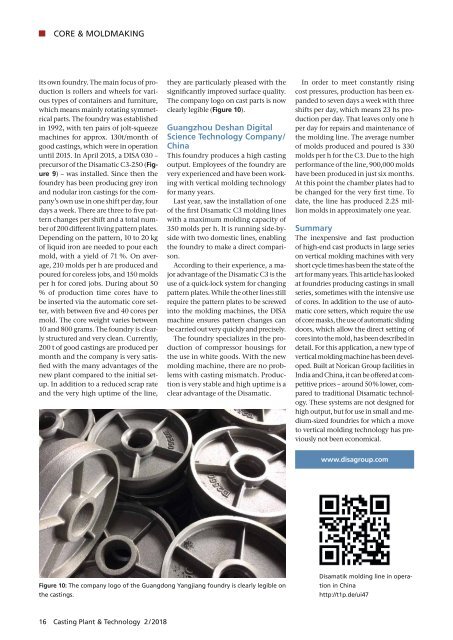CPT International 02/2018
- No tags were found...
Create successful ePaper yourself
Turn your PDF publications into a flip-book with our unique Google optimized e-Paper software.
CORE & MOLDMAKING<br />
its own foundry. The main focus of production<br />
is rollers and wheels for various<br />
types of containers and furniture,<br />
which means mainly rotating symmetrical<br />
parts. The foundry was established<br />
in 1992, with ten pairs of jolt-squeeze<br />
machines for approx. 130t/month of<br />
good castings, which were in operation<br />
until 2015. In April 2015, a DISA 030 –<br />
precursor of the Disamatic C3-250 (-<br />
) – was installed. Since then the<br />
foundry has been producing grey iron<br />
and nodular iron castings for the company’s<br />
own use in one shift per day, four<br />
days a week. There are three to five pattern<br />
changes per shift and a total number<br />
of 200 different living pattern plates.<br />
Depending on the pattern, 10 to 20 kg<br />
of liquid iron are needed to pour each<br />
mold, with a yield of 71 %. On average,<br />
210 molds per h are produced and<br />
poured for coreless jobs, and 150 molds<br />
per h for cored jobs. During about 50<br />
% of production time cores have to<br />
be inserted via the automatic core setter,<br />
with between five and 40 cores per<br />
mold. The core weight varies between<br />
10 and 800 grams. The foundry is clearly<br />
structured and very clean. Currently,<br />
200 t of good castings are produced per<br />
month and the company is very satisfied<br />
with the many advantages of the<br />
new plant compared to the initial setup.<br />
In addition to a reduced scrap rate<br />
and the very high uptime of the line,<br />
they are particularly pleased with the<br />
significantly improved surface quality.<br />
The company logo on cast parts is now<br />
clearly legible ().<br />
<br />
<br />
China<br />
This foundry produces a high casting<br />
output. Employees of the foundry are<br />
very experienced and have been working<br />
with vertical molding technology<br />
for many years.<br />
Last year, saw the installation of one<br />
of the first Disamatic C3 molding lines<br />
with a maximum molding capacity of<br />
350 molds per h. It is running side-byside<br />
with two domestic lines, enabling<br />
the foundry to make a direct comparison.<br />
According to their experience, a major<br />
advantage of the Disamatic C3 is the<br />
use of a quick-lock system for changing<br />
pattern plates. While the other lines still<br />
require the pattern plates to be screwed<br />
into the molding machines, the DISA<br />
machine ensures pattern changes can<br />
be carried out very quickly and precisely.<br />
The foundry specializes in the production<br />
of compressor housings for<br />
the use in white goods. With the new<br />
molding machine, there are no problems<br />
with casting mismatch. Production<br />
is very stable and high uptime is a<br />
clear advantage of the Disamatic.<br />
In order to meet constantly rising<br />
cost pressures, production has been expanded<br />
to seven days a week with three<br />
shifts per day, which means 23 hs production<br />
per day. That leaves only one h<br />
per day for repairs and maintenance of<br />
the molding line. The average number<br />
of molds produced and poured is 330<br />
molds per h for the C3. Due to the high<br />
performance of the line, 900,000 molds<br />
have been produced in just six months.<br />
At this point the chamber plates had to<br />
be changed for the very first time. To<br />
date, the line has produced 2.25 million<br />
molds in approximately one year.<br />
Summary<br />
The inexpensive and fast production<br />
of high-end cast products in large series<br />
on vertical molding machines with very<br />
short cycle times has been the state of the<br />
art for many years. This article has looked<br />
at foundries producing castings in small<br />
series, sometimes with the intensive use<br />
of cores. In addition to the use of automatic<br />
core setters, which require the use<br />
of core masks, the use of automatic sliding<br />
doors, which allow the direct setting of<br />
cores into the mold, has been described in<br />
detail. For this application, a new type of<br />
vertical molding machine has been developed.<br />
Built at Norican Group facilities in<br />
India and China, it can be offered at competitive<br />
prices – around 50 % lower, compared<br />
to traditional Disamatic technology.<br />
These systems are not designed for<br />
high output, but for use in small and medium-sized<br />
foundries for which a move<br />
to vertical molding technology has previously<br />
not been economical.<br />
<br />
The company logo of the Guangdong Yangjiang foundry is clearly legible on<br />
the castings.<br />
Disamatik molding line in operation<br />
in China<br />
http://t1p.de/ui47<br />
16 Casting Plant & Technology 2 / <strong>2018</strong>


















